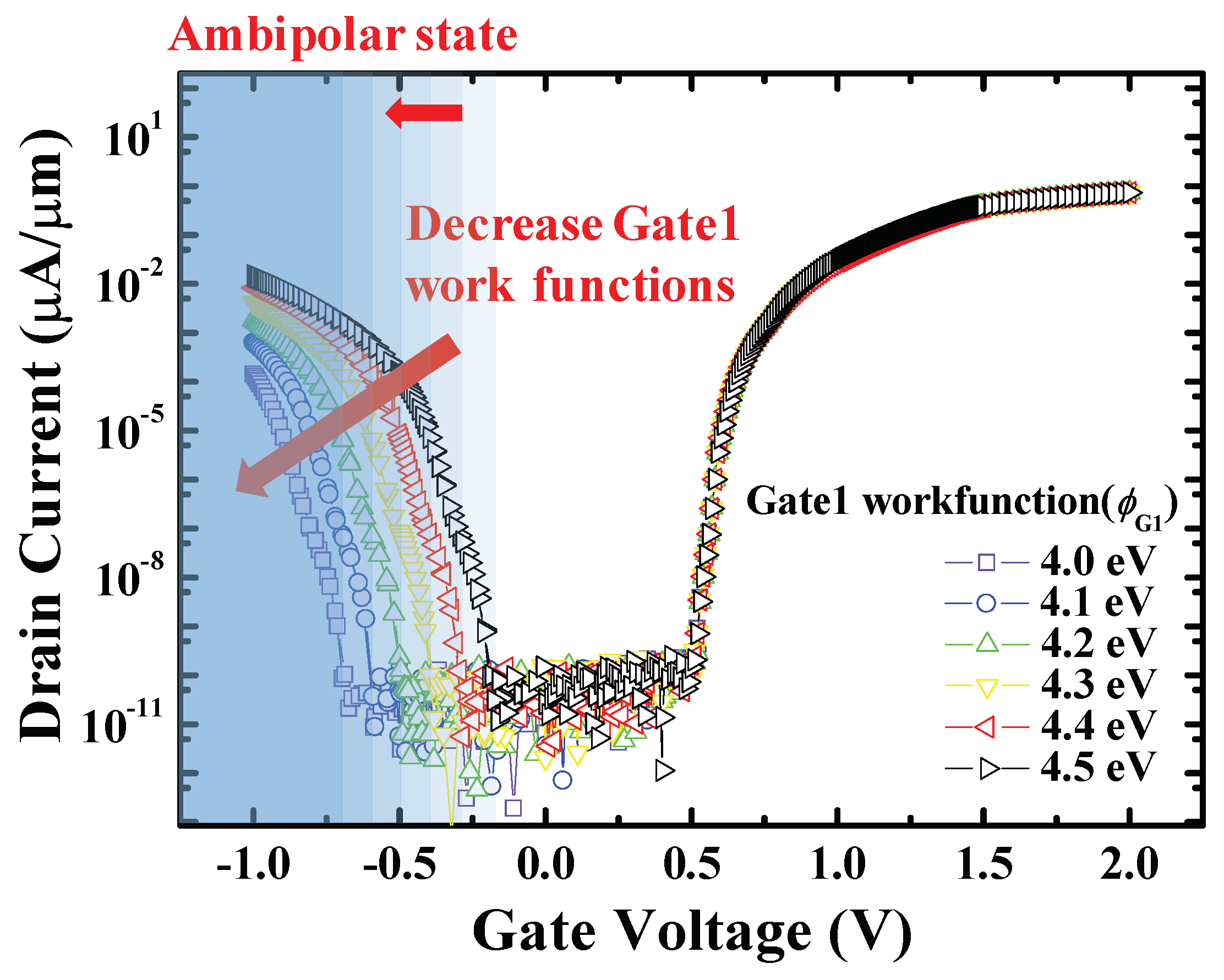Investigation on Ambipolar Current Suppression Using a Stacked Gate in an L-shaped Tunnel Field-Effect Transistor
Abstract
:1. Introduction
2. Device Structures and Simulation Methods
3. Results
3.1. Ambipolar Suppression of Stacked Gate L-Shaped TFET
3.2. Gate1 Work Function (ϕG1) Split
3.3. Resistance/on-Current
3.4. Process Flow
4. Summary
Author Contributions
Funding
Conflicts of Interest
References
- Choi, W.Y.; Park, B.; Lee, J.D.; Liu, T.K. Tunneling Field-Effect Transistors (TFETs) With Subthreshold Swing (SS) Less Than 60 mV/dec. IEEE Electron Device Lett. 2007, 28, 743–745. [Google Scholar] [CrossRef]
- Ionescu, A.M.; Riel, H. Tunnel field-effect transistors as energy-efficient electronic switches. Nature 2011, 479, 329. [Google Scholar] [CrossRef] [PubMed]
- Kim, H.W.; Kim, J.H.; Kim, S.W.; Sun, M.-C.; Kim, G.; Park, E.; Kim, H.; Kim, K.-W.; Park, B.-G. A Novel Fabrication Method for the Nanoscale Tunneling Field Effect Transistor. J. Nanosci. Nanotechnol. 2012, 12, 5592–5597. [Google Scholar] [CrossRef] [PubMed]
- Seabaugh, A.C.; Zhang, Q. Low-Voltage Tunnel Transistors for Beyond CMOS Logic. Proc. IEEE 2010, 98, 2095–2110. [Google Scholar] [CrossRef]
- Wang, P.F.; Hilsenbeck, K.; Nirschl, T.; Oswald, M.; Stepper, C.; Weis, M.; Schmitt-Landsiedel, D.; Hansch, W. Complementary tunneling transistor for low power application. Solid State Electron. 2004, 48, 2281–2286. [Google Scholar] [CrossRef]
- Gopalakrishnan, K.; Griffin, P.B.; Plummer, J.D. I-MOS: A novel semiconductor device with a subthreshold slope lower than kT/q. In Proceedings of the International Electron Device Meeting (IEDM), San Francisco, CA, USA, 8–11 December 2002; pp. 289–292. [Google Scholar]
- Qin, Z.; Wei, Z.; Seabaugh, A. Low-subthreshold-swing tunnel transistors. IEEE Electron Device Lett. 2006, 27, 297–300. [Google Scholar]
- Abdi, D.B.; Kumar, M.J. Controlling Ambipolar Current in Tunneling FETs Using Overlapping Gate-on-Drain. IEEE J. Electron Devices 2014, 2, 187–190. [Google Scholar] [CrossRef]
- Kim, S.W.; Choi, W.Y.; Sun, M.-C.; Kim, H.W.; Park, B.-G. Design Guideline of Si-Based L-Shaped Tunneling Field-Effect Transistors. Jpn. J. Appl. Phys. 2012, 51, 6–9. [Google Scholar]
- Kim, S.W.; Kim, J.H.; Liu, T.-J.K.; Choi, W.Y.; Park, B.-G. Demonstration of L-Shaped Tunnel Field-Effect Transistors. IEEE Trans. Electron Devices 2016, 63, 1774–1778. [Google Scholar] [CrossRef]
- Krishnamohan, T.; Kim, D.; Raghunathan, S.; Saraswat, K. Double-gate strained-Ge heterostructure tunneling FET (TFET) with record high drive currents and <60 mV/dec subthreshold slope. In Proceedings of the IEEE International Electron Devices Meeting (IEDM), San Francisco, CA, USA, 15–17 December 2008. [Google Scholar]
- Narang, R.; Saxena, M.; Gupta, R.; Gupta, M. Assessment of ambipolar behavior of a tunnel FET and influence of structural modifications. J. Semicond. Technol. Sci. 2012, 12, 482–491. [Google Scholar] [CrossRef]
- Toh, E.-H.; Wang, G.H.; Samudra, G.; Yeo, Y.-C. Device physics and design of double-gate tunneling field-effect transistor by silicon film thickness optimization. Appl. Phys. Lett. 2007, 90, 263507. [Google Scholar] [CrossRef]
- Verhulst, A.; Maex, K.; Groeseneken, G.; Vandenberghe, W. Tunnel field-effect transistor without gate-drain overlap. Appl. Phys. Lett. 2007, 91, 053102. [Google Scholar] [CrossRef]
- Kim, S.W.; Choi, W.Y.; Sun, M.C.; Park, B.G. Investigation on the corner effect of L-shaped tunneling field-effect transistors and their fabrication method. J. Nanosci. Nanotechnol. 2013, 13, 6376–6381. [Google Scholar] [CrossRef] [PubMed]
- Kwon, D.W.; Kim, H.W.; Kim, J.H.; Park, E.; Lee, J.; Kim, W.; Kim, S.; Lee, J.; Park, B. Effects of Localized Body Doping on Switching Characteristics of Tunnel FET Inverters with Vertical Structures. IEEE Trans. Electron Devices 2017, 64, 1799–1805. [Google Scholar] [CrossRef]
- Mertens, H.; Ritzenthaler, R.; Chasin, A.; Schram, T.; Kunnen, E.; Hikavyy, A.; Ragnarsson, L.-Å.; Dekkers, H.; Hopf, T.; Wos tyn, K. Vertically stacked gate-all-around Si nanowire CMOS transistors with dual work function metal gates. In Proceedings of the IEEE International Electron Devices Meeting (IEDM), San Francisco, CA, USA, 3–7 December 2016. [Google Scholar]











| Parameters | Definitions | Value |
|---|---|---|
| NS | Source doping concentration | Boron, 1 × 1020 cm−3 |
| NB | Channel doping concentration | Boron, 1 × 1016 cm−3 |
| ND | Drain doping concentration | Arsenic, 1 × 1019 cm−3, 1 × 1020 cm−3 |
| HS | Source height | 65 nm |
| HG1 | Gate1 height | 88 nm |
| HG2 | Gate2 height | 10 nm |
| Lt | Vertical tunneling thickness | 4 nm |
| Lch | Lateral channel length | 50 nm |
| Lun | Gate-drain underlap length | 9 nm |
| TB | Body thickness | 20 nm |
| TOX | Gate oxide thickness | 2 nm |
| VDS | Drain voltage | 0.7 V |
| ϕG1 | Gate1 work function | 4.0–4.5 eV |
| ϕG2 | Gate2 work function | 4.5 eV |
© 2019 by the authors. Licensee MDPI, Basel, Switzerland. This article is an open access article distributed under the terms and conditions of the Creative Commons Attribution (CC BY) license (http://creativecommons.org/licenses/by/4.0/).
Share and Cite
Yu, J.; Kim, S.; Ryu, D.; Lee, K.; Kim, C.; Lee, J.-H.; Kim, S.; Park, B.-G. Investigation on Ambipolar Current Suppression Using a Stacked Gate in an L-shaped Tunnel Field-Effect Transistor. Micromachines 2019, 10, 753. https://doi.org/10.3390/mi10110753
Yu J, Kim S, Ryu D, Lee K, Kim C, Lee J-H, Kim S, Park B-G. Investigation on Ambipolar Current Suppression Using a Stacked Gate in an L-shaped Tunnel Field-Effect Transistor. Micromachines. 2019; 10(11):753. https://doi.org/10.3390/mi10110753
Chicago/Turabian StyleYu, Junsu, Sihyun Kim, Donghyun Ryu, Kitae Lee, Changha Kim, Jong-Ho Lee, Sangwan Kim, and Byung-Gook Park. 2019. "Investigation on Ambipolar Current Suppression Using a Stacked Gate in an L-shaped Tunnel Field-Effect Transistor" Micromachines 10, no. 11: 753. https://doi.org/10.3390/mi10110753





